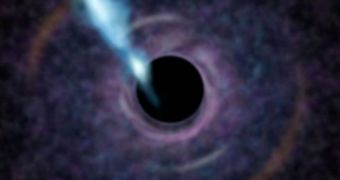Observations have finally revealed that largest supermassive black hole in the known Universe, which tips the scales at more than 6.6 billion solar masses. The enormous dark behemoth far exceeds all other black holes discovered thus far, astronomers say in a new study.
Measurements conducted with a direct observations technique show that the object is located relatively close-by, at a distance of just 54 million light-years. It is the closest supermassive black hole to Earth.
The good news in all of this is that, if we are ever to develop methods of seeing a black hole, this one will be the perfect candidate, due to its mass, proximity and distance.
It lies in the central region of the galaxy M87, also called NGC 4486, inside the Virgo galaxy cluster. The core of this super-giant elliptical galaxy forms an active galactic nucleus (AGN), which releases radiation in a multitude of wavelengths.
According to the team that conduct the new investigation, it could be that even more massive black holes can be found in the Universe, if this particular one is any indication.
Details of the finding have been organized into two scientific papers, which have been submitted and approved for publication in an upcoming issue of the esteemed Astrophysical Journal.
The work was also showcased in a presentation held on January 12 in Seattle, at the 217th winter meeting of the American Astronomical Society (AAS 2011), Space reports.
“Our ability to obtain such a robust black hole mass for M87 bodes well for our ongoing efforts to hunt for even larger black holes in galaxies more distant than M87,” explains scientist Tod Lauer.
The expert, who holds an appointment at the National Optical Astronomy Observatory, is also a co-author of the research papers. He adds that supermassive black holes are millions to billions of times heavier than our Sun.
Researchers were able to measure the mass of the black hole at the center of M87 by using a direct technique that calculates details on the motion of stars orbiting the dark behemoth. Whenever such an object is present, it distorts the orbits that stars take through galactic cores.
Data from a Texas-based observatory were combined with photos captured by the Gemini North telescope in Hawaii, which has an 8-meter aperture. This allowed the research effort to be 10 times more detailed than ever before.
According to University of Texas expert and study co-author Joshua Adams, this achievement was “just an enormous improvement compared to previous work.”
Ultimately, after more studies of this type, researchers may finally become able to prove that black holes actually exist, which is no small feat.

 14 DAY TRIAL //
14 DAY TRIAL //